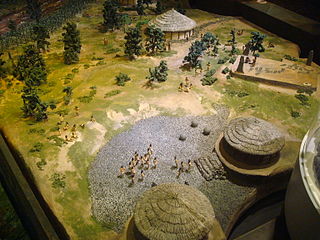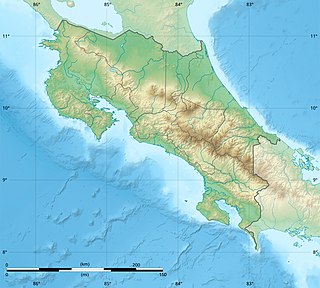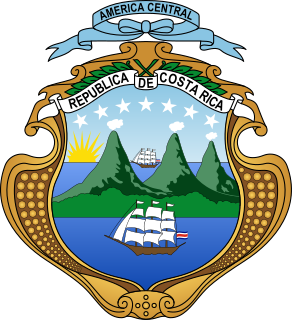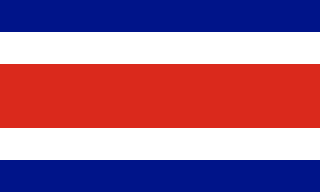Related Research Articles

Costa Rica, officially the Republic of Costa Rica, is a country in Central America, bordered by Nicaragua to the north, the Caribbean Sea to the northeast, Panama to the southeast, the Pacific Ocean to the southwest, and Ecuador to the south of Cocos Island. It has a population of around 5 million in a land area of 51,060 square kilometers. An estimated 333,980 people live in the capital and largest city, San José, with around 2 million people in the surrounding metropolitan area.

The first indigenous peoples of Costa Rica were hunters and gatherers, and when the Spanish conquerors arrived, Costa Rica was divided in two distinct cultural areas due to its geographical location in the Intermediate Area, between Mesoamerican and the Andean cultures, with influences of both cultures.

Costa Rica is located on the Central American Isthmus, surrounding the point 10° north of the equator and 84° west of the prime meridian. It has 212 km of Caribbean Sea coastline and 1,016 on the North Pacific Ocean.

The economy of Costa Rica has been very stable for some years now, with continuing growth in the GDP and moderate inflation, though with a high unemployment rate: 11.49% in 2019. Costa Rica's economy emerged from recession in 1997 and has shown strong aggregate growth since then. The estimated GDP for 2017 is US$61.5 billion, up significantly from the US$52.6 billion in 2015 while the estimated 2017 per capita is US$12,382.
The Public Force of Costa Rica is the country's law enforcement force, which performs policing and border patrol functions.

San José is the capital and largest city of Costa Rica, and the capital of the province of the same name. It is in the center of the country, in the mid-west of the Central Valley, within San José Canton. San José is Costa Rica's seat of national government, focal point of political and economic activity, and major transportation hub. San José Canton's population was 288,054 in 2011, and San José's municipal land area is 44.2 square kilometers, with an estimated 333,980 residents in 2015. Together with several other cantons of the central valley, including Alajuela, Heredia and Cartago, it forms the country's Greater Metropolitan Area, with an estimated population of over 2 million in 2017. The city is named in honor of Joseph of Nazareth.
The country of Costa Rica has many kinds of music.

According to Article 168 of the Constitution of Costa Rica, the political divisions are officially classified into 3 tiers of sub-national entities.

The Costa Rica national football team represents Costa Rica in men's international football. The national team is administered by the Costa Rican Football Federation (FEDEFUTBOL), the governing body for football in Costa Rica. It has been a member of the Fédération Internationale de Football Association (FIFA) since 1927, the Confederation of North, Central American and Caribbean Association Football (CONCACAF) since 1961, and a member of the Central American Football Union (UNCAF) since 1990.

The Legislative Assembly forms the unicameral legislative branch of the Costa Rican government. The national congress building is located in the capital city, San José, specifically in Carmen district of the San José canton.

The Costa Rican Football Federation, commonly known as FEDEFUTBOL or FEDEFUT, is the official association football governing body in Costa Rica and is in charge of the Costa Rica national football team.

Costa Rica is administratively divided into seven provinces which are subdivided into 82 cantons, and these are further subdivided into districts. Cantons are the only administrative division in Costa Rica that possess local government in the form of municipalities. Each municipality has its own mayor and several representatives, all of them chosen via municipal elections every four years.

Costa Rica first participated at the Olympic Games in 1936, but then missed the next four Olympiads. The nation returned to the Games in 1964, and has participated in every Summer Olympic Games since then. Costa Rica has also participated in several Winter Olympic Games since 1980.

Relations between Costa Rica and the United States have been historically close; nevertheless there were instances in history where the US and Costa Rica disagreed. One such example might be the case of Freebooter William Walker. Nevertheless, considering that Costa Rica generally supports the U.S. in international fora, especially in the areas of democracy and human rights, modern day relations are very strong.

The following outline is provided as an overview of and topical guide to Costa Rica:

Miss Costa Rica is a national beauty pageant in Costa Rica.
The Costa Rica women's national football team is controlled by the Costa Rican Football Federation. They are one of the top women's national football teams in the Central American region along with Guatemala.
Reinas de Costa Rica is a national beauty pageant in Costa Rica that selects representative to the Miss World pageant since 2007. The Miss Costa Rica pageant stopped sending contestants to the Miss World and Miss International pageants. The last delegate sent by the organization was in 2006. In 2007, the franchise was acquired by the Reinas de Costa Rica organization presided by Alan Aleman. This pageant is unrelated to the Miss Costa Rica Organization.

The COVID-19 pandemic in Costa Rica is part of the ongoing worldwide pandemic of coronavirus disease 2019 caused by severe acute respiratory syndrome coronavirus 2. The virus was confirmed to have spread to Costa Rica on 6 March 2020, after a 49-year-old woman tourist from New York, United States, tested positive for the virus.
References
| Wikimedia Commons has media related to Inbioxa . |
| Wikispecies has information related to Inbioxa . |